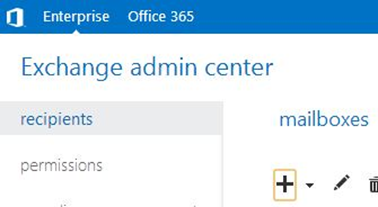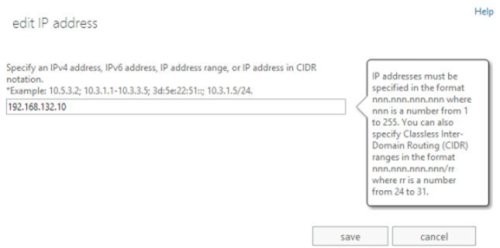Steps to setup:
- Configure the KACE SMA to accept mail.
- Create a mailbox that your employees can address via Active Directory.
- Create a contact that represents your KACE SMA.
- Create a Transport Rule to redirect mail to the KACE SMA.
- Create a receive connector so messages from the KACE SMA will be delivered.
- Create a send connector to route Exchange contact email to the KACE SMA.

1. Configure KACE SMA to Accept Mail
The KACE SMA Exim server is always running in this mode by default. The only thing needed here is to configure the email addresses that will be accepted.
Setup a queue:
Ø (Each queue is going to require a separate email address)
o The email address of the queue cannot be the same one used on Settings > Control Panel > Network Settings > Email Configuration.
- In the Web UI of the KACE SMA Go to “Service Desk” > “Configuration” > “Queues”.
- To create a queue select “Choose Action” and then “New”.
- Confirm that the domain suffix for the email address column is correct (ie. Kbox.mycompany.com) (red).
- Type in the name of the Queue (green).
- Type in the email address for the queue (orange).
- Type in an alternate email address which will modify the “From” of email sent from the KACE SMA (blue). This is the email address that your end users will use.
2. Create a mailbox that your employees can address via Active Directory
In Active Directory (or via the Exchange Management console) you should create a mailbox with the address that you want your end users to address. In our example that will be help@domain.com. This mailbox cannot be a "Shared Mailbox".
The steps below assume the following regarding the Exchange 2013/2016 server:
- An Exchange 2013/2016 server with both Mailbox and Client Access roles will be used.
- No user account, mailbox or contact exist for the KACE SMA.
First, log into the Exchange Management console via: https://exchange/ecp/default.aspx
Once logged into the Exchange Admin Center, verify that Enterprise is selected and that recipients > mailbox is in focus. From here, click on the + (New) button in the action bar to begin setting up the kbox mailbox.

In the new user mailbox screen that appears, populate the fields with the appropriate mailbox name specified in the KACE SMA Queue Configuration screen. The example below uses “kbox” for the account user name, so be sure to adjust this for your own environment as necessary.
Once the fields have been populated, complete the setup by clicking on the save button at the bottom of the screen.
• First name: kbox
• Alias: kbox
• Last name: kbox
• Display Name: kbox
• Name: kbox
• Logon name: help@domain.com
• New password: <password>
• Confirm password: <password>
Once the account has been created, an email address based on the applicable email address policy will be automatically generated (by default, based upon the User logon name from the previous step). To verify this, select the account and then select the email address item for the account. The email address listed should be the same as the KACE SMA Alt. Email Address specified earlier.
3. Create a contact that represents the KACE SMA
In Active Directory (or via the Exchange Management console) you should create a contact (not a mailbox) with the address of your KACE SMA. In our example that will be help@kbox.domain.com.
This contact will be used to facilitate email flow to the KACE SMA. It is pretty much the same idea as creating a new mailbox, but without an associated user account in the Exchange 2013 domain.
First, navigate to recipients > contacts, and then click on the + (New) button to begin the process.
Then, in the new mail contact screen, populate the fields as follows. The example below will use “kbox-contact” as the name, etc. for the contact itself and help@kbox.domain.com as the External email address (which corresponds with the KACE SMA Email Address configured earlier). Again, be sure to adjust these as necessary for your own environment.
|
First name: |
kbox-contact |
|
*Display Name: |
kbox-contact |
|
*Name: |
kbox-contact |
|
*Alias: |
kbox-contact |
|
*External email address: |
Once the fields have been populated, complete the setup by clicking on the save button at the bottom of the screen.
You will also want to hide this contact from address lists so choose the option Hide from Exchange address lists.
4. Create a Transport Rule to redirect mail to the KACE SMA
Getting all messages to flow from the kbox mailbox (addressable by domain.com users) to the kbox-contact contact is the goal of the next step. This is accomplished by way of a rule, which is configured in the mail flow > rules section. If you are going to create more than one queue, one transport rule per queue is going to be required. Repeat the same process with the rest of the queues to route the ticket from the kbox mailbox to the kbox-contact.
To create a new rule: Click on the + (New) button.
Continue by specifying the following conditions, adjusting recipients to match your own environment:
|
Name: |
kbox redirect |
|
|
*Apply this rule if... |
The recipient is... |
'kbox' |
|
*Do the following... |
Redirect the message to... |
'kbox-contact' |
When finished, click on the save button to create the rule.
5. Create a receive connector so messages from the KACE SMA will be delivered
In order to get messages from the KACE SMA delivered to users within the Exchange 2013 domain, a scoped receive connector needs to be created. To begin with, navigate to mail flow > receive connectors and then click the + (New) button.
In the subsequent new receive connector screen, complete the fields as follows and then click next:
· Name: KACE SMA Frontend <your Exchange 2013 server name here>
· Role: Frontend Transport
· Type: Custom (For example, application relay)
On the *Network adapter bindings screen, verify the following and then click next.
· IP ADDRESSES: (All available IPv4)
· PORT: 25 or 587
The *Remote network settings screen is where the receive connector will be scoped to only accept email from the KACE SMA. To make this adjustment, click the pencil (Edit) button.
In the subsequent edit IP address screen, enter the IP address of the KACE SMA (192.168.132.10 in the example below). Once completed, click the save button.

Now that all configuration settings have been specified, click the finish button to create the receive connector.
Now that the scoped receive connector has been created, all that remains is to tweak its permissions. To do this, select the KACE SMA Frontend <your Exchange 2013 server name here> object and then click the pencil (Edit) button to go into the object’s properties.
Finally, select security from the item’s menu; enable the Anonymous users option under the Permission groups section and click the save button to apply. This option will allow KACE SMA email to reach the Exchange 2013 server without authentication.
The emails from the KACE SMA will now reach users within your company (assuming they have email addresses defined on the KACE SMA).
Note that while it is possible to enable the Anonymous users option for the Default Frontend connector to enable mail flow from the KACE SMA, this is usually not recommended as it allows any connection to anonymously utilize the receive connector and might be a security risk.
6. Create a send connector to route Exchange contact email to the KACE SMA
Create the send connector which will take messages ultimately destined for the help@kbox.domain.com contact and send them on to the KACE SMA. One thing to note is that if multiple KACE SMA queues are employed, only one send connector is necessary – additional mailbox/contact/rule sets will use the send connector configured here to route messages, as long as the contact’s email address specifies kbox.domain.com.
To create a send connect in Exchange 2013, navigate to mail flow > send connectors and click on the + (New) button.
In the subsequent new send connector screen, specify a *Name for the send connector (in this example, “kbox connector”) and the Type (Custom), then click on the next button.
On the *Network settings screen, select the Route mail through smart hosts option, then click on the + (New) button above the SMART HOST section to specify the IP address of the KACE SMA (192.168.132.10 in the example below). Once completed, click the next button.
On the following screen, specify none for Smart host authentication, and then click next.
For the *Address space section, click on the + (New) button to specify the KACE SMA Email subdomain.
In the add domain screen, complete the fields as follows (being sure to replace “domain.com” with your own domain name) and then click save:
· Type: SMTP
· Full Qualified Domain Name (FQDN): kbox.domain.com
· Cost: 1
The next step is to specify the Exchange 2013 server as the source server, as in “the source for messages which need sent onto the KACE SMA”. First, click on the + (New) button.
In the following screen, select the Exchange 2013 server, click the Add button to include the server and then click the OK button to specify the server as the source server.
If you have multiple servers which may fulfill this role (as in a clustered environment), be sure to include them here so that messages will be sent to KACE SMA regardless of which server is processing them.
To finish
setting up the send connector, click on the Finish button.
Note: When testing the
Service Desk functionality please use a different user account for the
Submitter, Owner, Ticket CC, Category CC. This will allow you to view the full
email flow.
For example: If you are testing the email notification after a comment is added
to the ticket, you need to login to the appliance with a different account to
add the comment and not the same one used to submit the ticket. The K1000 is
not going to send you a notification if you are modifying your own ticket.

Comments